Ovine mastitis is a very common disease worldwide, but the severity of the ailment is frequently underappreciated due to its low diagnosis. This was the scene set by veterinary specialist Ryan Duffy, speaking at the recent Irish Grassland Association sheep conference held in Roscommon.
The extent to which the disease is underdiagnosed at industry level was highlighted by the fact that between 2011 and 2020, there were just seven cases reported in the annual All Island Animal Disease Surveillance Reports. Ryan outlined however that data from other countries demonstrates how mastitis is a much greater problem.
In countries with significant sheep dairy flocks including Greece, Portugal and Spain, mastitis is a substantial issue, with problems identified much easier by the fact that udders are examined daily and regular milk testing takes place.
Data from the UK, where the production system is similar to Ireland, highlights that the prevalence of clinical mastitis in ewes sent for slaughter ranged anywhere from 13% to 50%. Other studies found that mastitis attributed for up to 46% of voluntary culling decisions, while analysis of ewe deaths in two studies found intramammary infections responsible for 8.4% and 12.8% of deaths, respectively.
Disease presentation
Ryan commented that the effect of mastitis is possibly more significant in sheep flocks than dairy flocks, due to the fact that there are two anatomically distinct mammary glands in ewes, meaning production loss and longevity of affected animals are hit hard.
There are two main forms of ovine mastitis – clinical mastitis and subclinical mastitis. Clinical mastitis is usually considered to be the greater issue, due mainly to the fact that it manifests with clinical symptoms that are apparent. However, Ryan outlines that clinical mastitis is likely to only be responsible for a fraction of intramammary infections, with subclinical presentation often not considered as a possible cause or occurring without being identified.
Sometimes, the only sign of disease in meat production systems is poor lamb performance. Studies show that the resultant decrease in milk quality and quantity contributes to the average daily gain of lambs reducing by 20g/day or 4kg at weaning, while increased cases of mis-mothering and poor lamb vitality are other possible consequences.
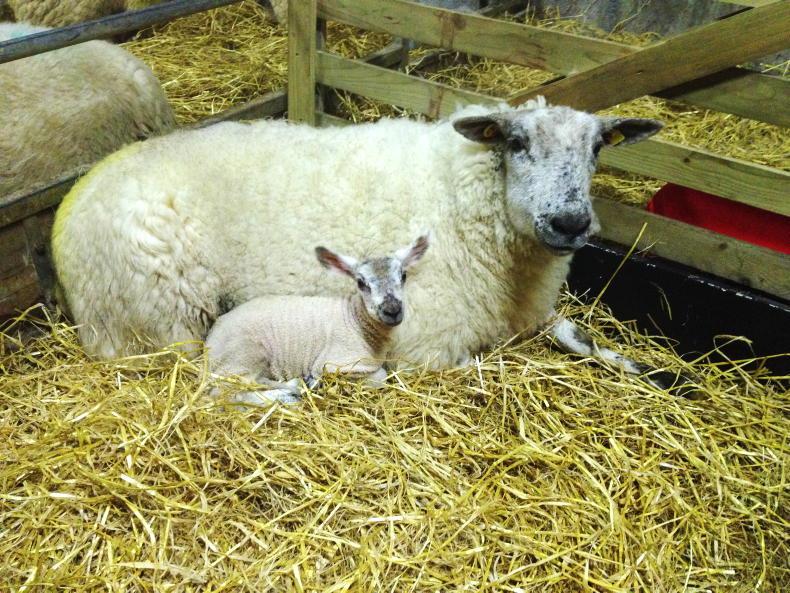
Hygiene in lambing pens is vital to prevent the entry of bacteria into the mammary gland.
The timing of infection is also misrepresented, due mainly to the fact that ewes are usually only handled to check udders at lambing, weaning and possibly shearing. This leaves a large window where, according to Ryan, cases are likely to be missed in the absence of an obviously sick animal during the established lactation and dry periods.
Low diagnosis and missed treatments increase the risk of bacterial infection and progression to chronic cases. This is a major contributing cause to mastitis in ewes, manifested as palpable hard lumps or abscesses within the mammary gland that respond poorly to treatment.
Clinical signs
Clinical mastitis is typically seen in three forms – peracute, acute and chronic. The peracute form is frequently referred to as ‘blue bag’ resulting from discolouration of the swollen affected mammary gland due to gangrene.
This form of mastitis is often fatal, even with aggressive treatment, and also rapidly results in systemic toxaemia, marked depression and circulatory collapse. Treatment here should also take account of the risk of blowfly strike in the affected mammary gland, which usually falls off.
Acute mastitis is generally represented by an inflamed and swollen mammary gland with an abnormal serum-like secretion, which can appear watery, clotted or purulent (pus-filled). Lameness is often an early clinical sign of mastitis and as such, any animals struggling with movement should be examined for the presence of mastitis.
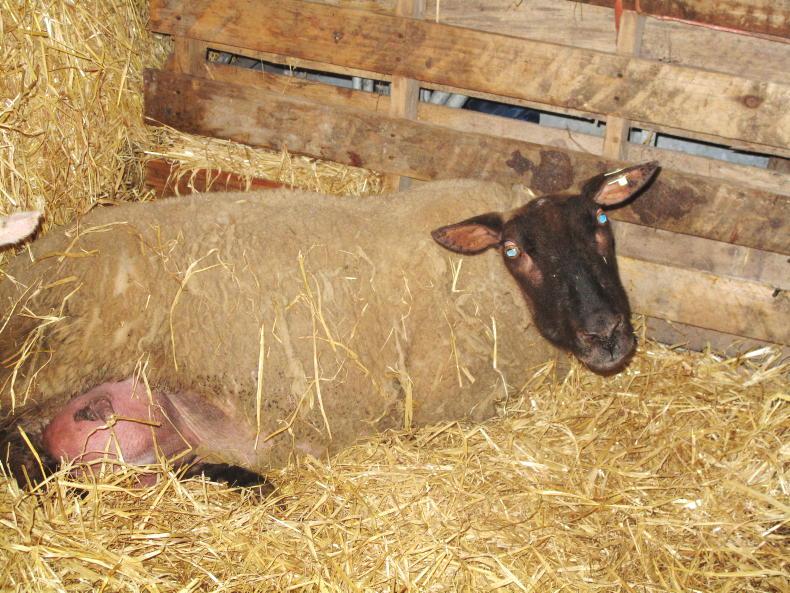
An affected ewe with a swollen mammary gland.
Ryan says the chronic form of mastitis is often the most frequently detected on Irish farms. He highlights the presence of “ping-pong ball-like” abscesses throughout the mammary gland and states that in many cases, these may be noticeable. It is often first identified in ewes that lamb down with little or no milk. There is no consistent effective therapeutic treatment when the condition has reached this stage.
Causative agents
The cause of mastitis is typically due to bacteria gaining entry to the mammary gland via an open teat canal. Staphylococci species are the main threat, with Staphylococcus Aureus the greatest pathogen responsible. The two main sources of infection are persistently infected stock acting as a reservoir for disease and an inadequately maintained environment.
Staphylococci species are renowned for being highly contagious and contribute to high somatic cell counts in addition to being hard to treat. If submitting milk samples for analysis, a word of caution surrounds getting two people to take the sample to avoid possible contamination.
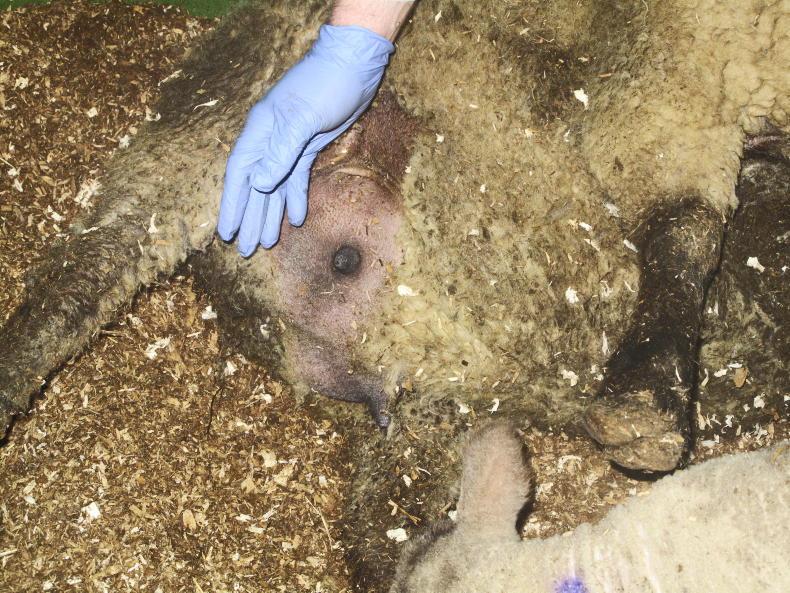
Staphylococci species are highly contagious and high standards of hygiene should be practiced.
The high risk period for environmental mastitis is when sheep are housed, with Ryan referring to this period as ‘the housing headache’. Studies have shown a positive effect on udder health where sheep were provided with housing space of 2m2, which is generally not practical.
Ryan said that in an ideal world, a well-ventilated shed with a plastic slatted floor would reduce the risk, but straw-bedded houses should still be ok as long as standards of hygiene are excellent.
Regular disinfection of the housing environment and adequate nutrition were also highlighted as having a massive influence in reducing the risk of disease establishing, with inadequate nutrition compromising natural immunity in ewes.
Treatment options
Diagnosing the cause of mastitis is central to antibiotic choice. This should be determined in conjunction with the farm’s vet. Anti-inflammatories are also an important component of successful treatment strategies and these are also crucial in terms of animal welfare.
Responding to questions about the role of intramammary cow tubes, Ryan advises that these are a waste of time for treating ewes, as the infection is usually high up in the mammary gland and out of reach of medication deposited via the teat canal.
Nutrition is again highlighted as being central to promoting swift recovery, as is ensuring sick animals are hydrated (fresh water and electrolyte solution for toxaemic animals). It is important to remove suckling lambs temporarily or permanently, depending on the severity of the illness.
A new vaccine, Vimco mastitis vaccine, is now available and is targeted at high value animals and milking flocks.
The incidence of mastitis in ewes is greatly underdiagnosed and underappreciated.Subclinical mastitis is a bigger issue than many realise, leading to low milk yield and poor lamb performance. Prevention centres on reducing environmental risks and optimum ewe nutrition. Treatment strategies focus on administering antibiotics and anti-inflammatories, along with nutrition and hydration.
Ovine mastitis is a very common disease worldwide, but the severity of the ailment is frequently underappreciated due to its low diagnosis. This was the scene set by veterinary specialist Ryan Duffy, speaking at the recent Irish Grassland Association sheep conference held in Roscommon.
The extent to which the disease is underdiagnosed at industry level was highlighted by the fact that between 2011 and 2020, there were just seven cases reported in the annual All Island Animal Disease Surveillance Reports. Ryan outlined however that data from other countries demonstrates how mastitis is a much greater problem.
In countries with significant sheep dairy flocks including Greece, Portugal and Spain, mastitis is a substantial issue, with problems identified much easier by the fact that udders are examined daily and regular milk testing takes place.
Data from the UK, where the production system is similar to Ireland, highlights that the prevalence of clinical mastitis in ewes sent for slaughter ranged anywhere from 13% to 50%. Other studies found that mastitis attributed for up to 46% of voluntary culling decisions, while analysis of ewe deaths in two studies found intramammary infections responsible for 8.4% and 12.8% of deaths, respectively.
Disease presentation
Ryan commented that the effect of mastitis is possibly more significant in sheep flocks than dairy flocks, due to the fact that there are two anatomically distinct mammary glands in ewes, meaning production loss and longevity of affected animals are hit hard.
There are two main forms of ovine mastitis – clinical mastitis and subclinical mastitis. Clinical mastitis is usually considered to be the greater issue, due mainly to the fact that it manifests with clinical symptoms that are apparent. However, Ryan outlines that clinical mastitis is likely to only be responsible for a fraction of intramammary infections, with subclinical presentation often not considered as a possible cause or occurring without being identified.
Sometimes, the only sign of disease in meat production systems is poor lamb performance. Studies show that the resultant decrease in milk quality and quantity contributes to the average daily gain of lambs reducing by 20g/day or 4kg at weaning, while increased cases of mis-mothering and poor lamb vitality are other possible consequences.

Hygiene in lambing pens is vital to prevent the entry of bacteria into the mammary gland.
The timing of infection is also misrepresented, due mainly to the fact that ewes are usually only handled to check udders at lambing, weaning and possibly shearing. This leaves a large window where, according to Ryan, cases are likely to be missed in the absence of an obviously sick animal during the established lactation and dry periods.
Low diagnosis and missed treatments increase the risk of bacterial infection and progression to chronic cases. This is a major contributing cause to mastitis in ewes, manifested as palpable hard lumps or abscesses within the mammary gland that respond poorly to treatment.
Clinical signs
Clinical mastitis is typically seen in three forms – peracute, acute and chronic. The peracute form is frequently referred to as ‘blue bag’ resulting from discolouration of the swollen affected mammary gland due to gangrene.
This form of mastitis is often fatal, even with aggressive treatment, and also rapidly results in systemic toxaemia, marked depression and circulatory collapse. Treatment here should also take account of the risk of blowfly strike in the affected mammary gland, which usually falls off.
Acute mastitis is generally represented by an inflamed and swollen mammary gland with an abnormal serum-like secretion, which can appear watery, clotted or purulent (pus-filled). Lameness is often an early clinical sign of mastitis and as such, any animals struggling with movement should be examined for the presence of mastitis.

An affected ewe with a swollen mammary gland.
Ryan says the chronic form of mastitis is often the most frequently detected on Irish farms. He highlights the presence of “ping-pong ball-like” abscesses throughout the mammary gland and states that in many cases, these may be noticeable. It is often first identified in ewes that lamb down with little or no milk. There is no consistent effective therapeutic treatment when the condition has reached this stage.
Causative agents
The cause of mastitis is typically due to bacteria gaining entry to the mammary gland via an open teat canal. Staphylococci species are the main threat, with Staphylococcus Aureus the greatest pathogen responsible. The two main sources of infection are persistently infected stock acting as a reservoir for disease and an inadequately maintained environment.
Staphylococci species are renowned for being highly contagious and contribute to high somatic cell counts in addition to being hard to treat. If submitting milk samples for analysis, a word of caution surrounds getting two people to take the sample to avoid possible contamination.

Staphylococci species are highly contagious and high standards of hygiene should be practiced.
The high risk period for environmental mastitis is when sheep are housed, with Ryan referring to this period as ‘the housing headache’. Studies have shown a positive effect on udder health where sheep were provided with housing space of 2m2, which is generally not practical.
Ryan said that in an ideal world, a well-ventilated shed with a plastic slatted floor would reduce the risk, but straw-bedded houses should still be ok as long as standards of hygiene are excellent.
Regular disinfection of the housing environment and adequate nutrition were also highlighted as having a massive influence in reducing the risk of disease establishing, with inadequate nutrition compromising natural immunity in ewes.
Treatment options
Diagnosing the cause of mastitis is central to antibiotic choice. This should be determined in conjunction with the farm’s vet. Anti-inflammatories are also an important component of successful treatment strategies and these are also crucial in terms of animal welfare.
Responding to questions about the role of intramammary cow tubes, Ryan advises that these are a waste of time for treating ewes, as the infection is usually high up in the mammary gland and out of reach of medication deposited via the teat canal.
Nutrition is again highlighted as being central to promoting swift recovery, as is ensuring sick animals are hydrated (fresh water and electrolyte solution for toxaemic animals). It is important to remove suckling lambs temporarily or permanently, depending on the severity of the illness.
A new vaccine, Vimco mastitis vaccine, is now available and is targeted at high value animals and milking flocks.
The incidence of mastitis in ewes is greatly underdiagnosed and underappreciated.Subclinical mastitis is a bigger issue than many realise, leading to low milk yield and poor lamb performance. Prevention centres on reducing environmental risks and optimum ewe nutrition. Treatment strategies focus on administering antibiotics and anti-inflammatories, along with nutrition and hydration. 







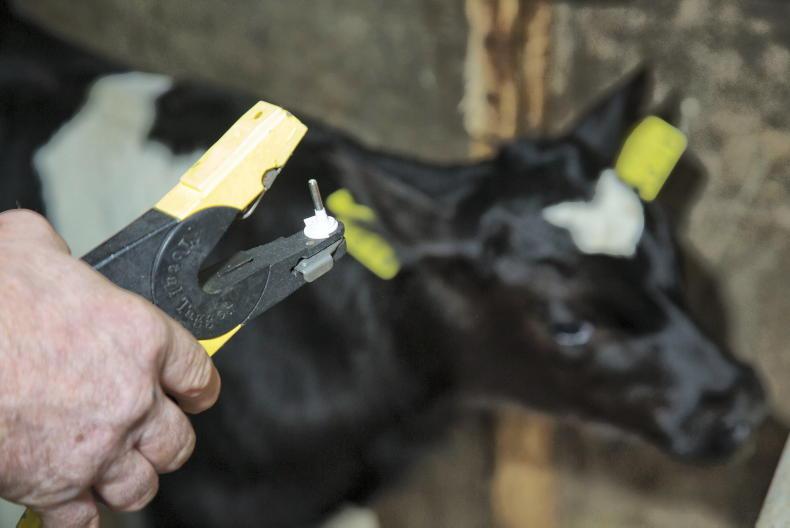

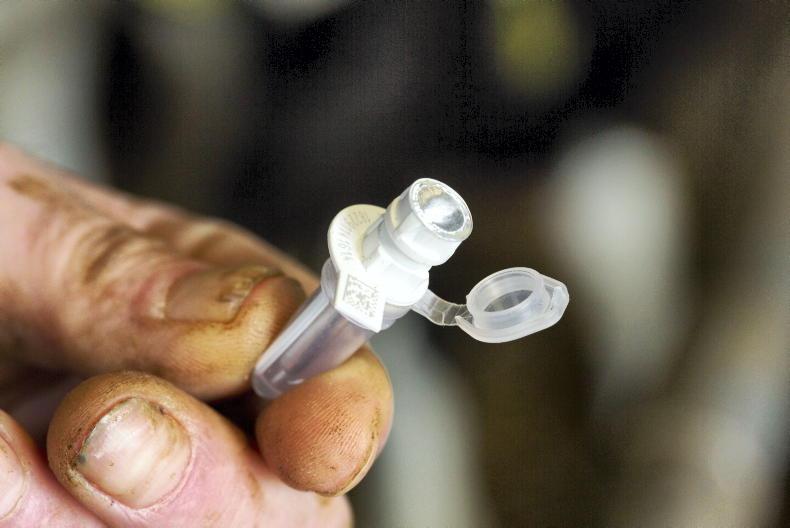

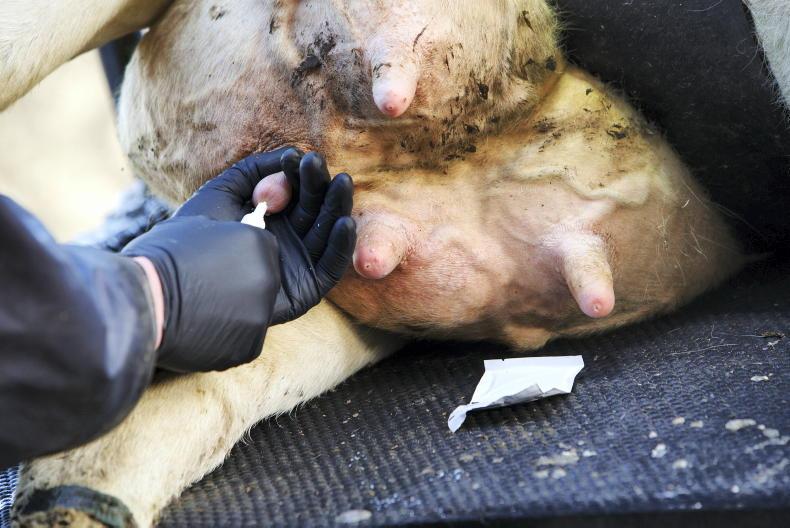
SHARING OPTIONS